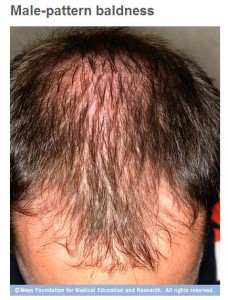-
Health & Wellness
TUESDAY Q & A: Teen’s hair loss likely result of genetics, but treatment options available
DEAR MAYO CLINIC: My son, 19, has been losing his hair for about a year. He has been using a hair growth foam for about 6 months without much difference.  He is healthy otherwise and exercises daily. He is a baseball player and wears a cap often, but it seems like a lot of hair loss for someone his age. Is there anything else he could do at this point? Should he see a dermatologist?
He is healthy otherwise and exercises daily. He is a baseball player and wears a cap often, but it seems like a lot of hair loss for someone his age. Is there anything else he could do at this point? Should he see a dermatologist?
ANSWER: In the vast majority of cases like your son’s, the cause of hair loss is a condition called androgenic alopecia, or male-pattern baldness. It’s usually a result of genetics and not a sign of a more serious underlying medical condition. Treatment that can slow or stop this type of hair loss is available. To confirm the diagnosis and decide on treatment options, he should make an appointment to see a dermatologist — preferably one who has expertise in hair loss.
Male-pattern hair loss is characterized by the hairline receding from the forehead, as well as thinning hair across the top of the head. If the hair loss continues over time, these two areas may merge. The result often is a ring of hair around the sides and the back of the head, with baldness over the top.
Male-pattern baldness happens because of genetics. A widely held myth is that the genes for this type of hair loss are passed down through the mother’s side of the family. In fact, male-pattern baldness can be inherited through either side of a family, or it may come from both sides. Depending on a person’s genetic make-up, hair loss of this type can begin any time after puberty. The rate of hair loss and how far it progresses is also based on genetics.
Several effective treatment options are available for male-pattern baldness. The over-the-counter medication minoxidil — brand name Rogaine — is applied directly to the scalp. It often works well, but only if it is used consistently over time. It is important to understand that the goal of this medication is to stop the process of hair loss. Only in very rare cases will it cause hair that has stopped growing to begin to grow again. That may not be what your son is hoping for now. But in ten to fifteen years, it will make a significant difference in the amount of hair he has at that time compared to what it would be if his current rate of hair loss continues.
Another treatment option available is the prescription drug finasteride (brand name Propecia), which can be used alone or in conjunction with minoxidil. This medication comes in pill form and needs to be taken every day. The purpose of finasteride also is to stop hair loss, not to regrow new hair.
Behaviors such as regularly wearing a baseball cap or frequent hair brushing do not have an effect on hair loss. Using shampoos, conditioners, serums or creams marketed to reverse hair loss won’t make a difference, either. There is no evidence that any vitamins or dietary supplements can regrow hair.
At this time, the best option is for your son to see a dermatologist to discuss his hair loss. If possible, find one who specializes or has specific training in hair loss. Although it is very unlikely that hair loss can be reversed, if your son begins treatment now, he may be able to slow the rate of hair loss and maintain the amount of hair he has for many years to come. — Rochelle Torgerson, M.D., Ph.D., Dermatology, Mayo Clinic, Rochester, Minn.







